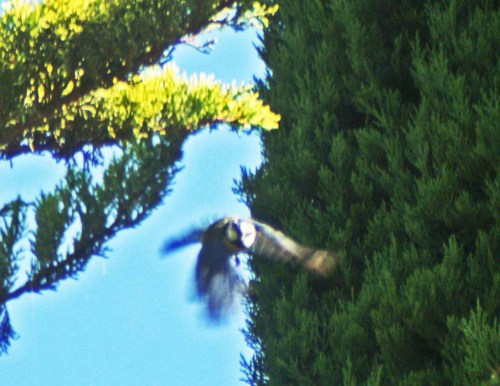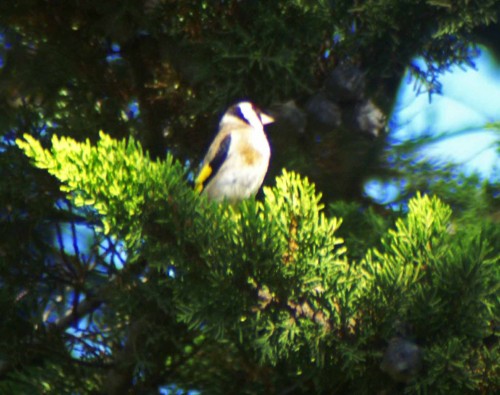June 12th
Summer arrived overnight and the thermostat shot up a few notches this week giving us some scorching days and hot nights that don’t usually arrive till July. Today the local beaches were ablaze with colour, and car parks overflowed, as local families headed for the cooler seaside, a regular event throughout the summer on Sundays, but this was the first one to occur on this scale this year. Each family, that includes grandparents and every other relative through to infants, sets up a colourful camp of parasols and gazebos, collapsible chairs, tables and towels in one unbroken line where possible, extending from one end of the beach to the other, just a couple of metres back from the sea edge. They arrive early, equipped with portable barbeques, plenty of food and drink and many will still be there till very late in the evening.
There is none of the self-conscious display of reserve we’re used to on British beaches, where we set up our camps as far away from each other as possible in an untidy hotch-potch, surround ourselves with windbreaks for privacy as well as protection and erect a unique (well we hope unique) makeshift flag so our kids can find their way back to us when they’re done paddling! Goodness knows how wandering children find their way back to their camp here, although I have heard it rumoured that each family has their ‘own’ spot on their local beach, and any unsuspecting tourist that may inadvertently set up in it will either be closely surrounded or otherwise encouraged to vacate it.
Monday June 13th
We discovered several tiny Praying mantids on a sage plant this morning. Perfect miniatures of the adults, they were maybe 2.5 – 3cm long and very aware of being noticed. They will have very recently emerged from their communal ‘ootheca’ or egg case, along with their siblings that could number up to 300 or more. Naturally they are very vulnerable to predation while at this stage and it will take the whole summer for them to grow into adults.
Generally most of the local birds appear to be done with nesting and on to the hard part – keeping up with their teenagers!
Wednesday June 15th
I see and hear families of Blue Tits, Great Tits, Goldfinches and Greenfinches most mornings as they are foraging in the trees in the cooler hours of the mornings, and I caught a glimpse of a male Chaffinch being very attentive to one of his very demanding youngsters.
I photographed them in our sprawling cypress tree, the one I think of in terms of ‘the big ugly’ as it is a bit of a pain, constantly dropping dead needles and is really not beautiful. But, it is such a haven for the birds and provides perches for the insect hunting Flycatchers as well as welcome shade. There’s food for some birds too at the moment, I’ve seen Great Tits and Greenfinches eating the seeds from its little cones, although only a few are open as yet.
There have been several visits from Kestrels this week, and although I haven’t spotted one until it has flown up from its perch, usually high up in one of the palm trees, the smaller birds have always given it away. Blackbirds in particular sound a very loud alarm and the Spotted Flycatchers keep up a constant ‘tcking’, but most others are noticeable by their complete silence and lack of activity.
Our view of tonight’s eclipse of the moon was not as dramatic as we hoped, but we did almost forget about it. The photograph doesn’t do it justice as it did look truly beautiful; it was bright and luminous, as though it was lit from the inside and its features were very clear.
Saturday June 18th
I’ll be returning to the UK shortly and will be gone for most of the summer, so I drove over to Jimena this afternoon to spend a couple of hours with my friend. As always the drive over there was scenic and I saw a surprising number of birds. The roadside are still full of wildflowers; there were masses of frothy white blossoms of wild carrot and related species and more fennel than I have ever seen, in fact there were some large fields absolutely covered with a tapestry of creamy white and lime green. In several places there were splashes of colour too, where clumps of the intensely pink common centaury were growing.
Summer is the best time to see raptors and on my short journey I saw a good few. I first stopped to watch a Kestrel hovering over a field close to the road, a lovely sight as it dived down then swooped up again, intently scanning the ground beneath it. Along the main road I couldn’t fail to see a large flock of Griffon Vultures that were circling low over the brow of a hill beyond one expanse of flowery field, they must have been intent on feeding, but I daren’t stop to have a proper look. I counted at least 30 birds and there were probably more behind the hill or on the ground. The collective noun for a flock of vultures is a ‘venue of Vultures’ , unless they are circling, in which case it is a ‘kettle of vultures’. (wikipedia)
At the road bridge over the railway line there were three Lesser Kestrels flying around, but I was able to pull in for a quick look at them. I had a great view of a Short-toed Eagle as it flapped away low over a field too.
At my friend’s house it was scorching hot, the thermometer inside reading 26°C, and outside in the walled garden it was even hotter. We sat in the shade of the sun room, with a glass of delicious home-made lemonade, freshly made from fruit from her own tree. (Since it began to get very hot the tree has dropped all its remaining ripe fruit, probably as a way of conserving moisture for the new crop that is already beginning to swell.) There was entertainment too, a pale coloured gecko, possibly one of the biggest, plumpest ones I have ever seen, waddled over the wall and squeezed itself behind the wooden frame of a trellis.
The area is being plagued by small black flies at the moment, troublesome to people, but they are being assisted in their disposal by Swallows and in particular House Martins that were swooping around, chattering constantly as they flew here, there and everywhere close together in family groups. The close views of their aerial acrobatics was delightful, particularly as parents were feeding young ones on the wing, the two hovering closely together for a split second to make the pass. They were momentarily stunned into silence, scattering into cover as we had a surprise, very close-up visit from a Booted Eagle (light-phase), clearly drawn by all the activity and noise. Wow. It didn’t catch anything though.
The stars of the afternoon though were the Red-rumped Swallows. There have been one or two pairs returning to the immediate area for the last few years, and although they have shown interest in this garden and have roosted in the small covered area, have not nested – until now.
The Red-rumped Swallow builds a very distinctive nest, made of mud as those of other hirundines, but with the addition of a long tunnel through which the birds access the main chamber. This one is in the shade provided by a concrete and cement block utility area attached to the house next door, but we had very good views of it over the top of the garden wall.
The pair clearly have nestlings and the rate of their feeding was impressive, with one or other of them returning every 2 minutes or so at one point. Red-rumped Swallows are known to have regular ‘hunting’ routes and here they fly very closely to the house, sometimes skimming the swimming pool, then up and over the roof circling around to reappear from the garden on the other side to the one they are nesting in.
Returning from a wander around the garden, our attention was diverted to the ground by the sight of a mass of ants labouring to haul a butterfly chrysalis across the terrace. Back at the nest entrance they spent some time attempting to force the bulky prey in through the narrow crack in the cement between bricks, turning it this way and that to no avail.
Naturally, being ants, notoriously resourceful and enterprising, they persisted in their attempts to get the pupa in. We thought they may have to resort to cutting it into smaller pieces, but then considered the possibility that it may well still be a bit of a gooey mess inside and may not store well if opened up.Meanwhile, another hunting party was returning with their ‘bag’ – a wasp or large hoverfly, still quite large but that appeared small enough to fit in with less problems. The others must have thought so too, so moved their chrysalis out of the way to let the wasp haulers through.
A hugely entertaining afternoon with some very special moments and all while enjoying a chat and hardly leaving our comfortable seats. Who needs TV?






















The image labelled Cistanche is in fact Orobanche densiflora. Lovely photo.
LikeLike
Thank you for your comment and the correction, I’m flattered you looked at the blog and took the time to put me right. It is much appreciated as it helps my own learning and makes sure any information I give in the blog is right. I have updated the post accordingly – and have signed up to follow your blog. Will buy the book too, Marjorie Blamey doesn’t mention that particular species!
LikeLike
Nice to meet you! You’re more than welcome. I get lots of people sending me photos of unusual plants they’ve seen to ID and I love it! I do hope you enjoy the book – it’s been a few years in the making so I’m relieved it’s finally done! You can also email me if you ever have plants you’re unsure of: chris.thorogood@bristol.ac.uk
Best wishes
Chris
LikeLike
Thank you for the email link and the offer of help with ID, it’s much appreciated. I have quite a back library of photographs of Cadiz/Malaga flora to process, so you may well be hearing from me!
LikeLike